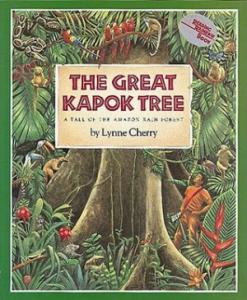Ugh, what a preachy book. Gag me!

Two men go into a forest, one of them points at this kapok tree, and leaves, and the other one takes an axe and starts cutting it down, then gets tired and goes to sleep. While he's asleep, various animals come and lecture the crap out of this guy about how chopping down trees in the rain forest is bad. The pictures are beautiful, the words are true, and the message is true, and it's a good message, but who is this book written for? The people who are cutting down trees in the rain forest are not going to read a children's book printed in English in the United States. The animals all speak English except for the word "Senhor," the Portuguese word for "Mister", so it's a wonder the presumably Brazilian man understands them at all.
The snake says, "Generations of my ancestors have lived in this tree." The bee says, "Hey, I pollinate things?" The monkeys say, "If you chop down this tree, you're going to chop down another one," an unintentional lesson in the slippery slope fallacy. Do the monkeys live in the tree? They don't say that. They just say, "If you chop down the trees, the roots will die, and then the rains will come, and the forest will turn into a desert." Then the birds come down from the canopy and, again, they don't say, "We need this particular tree," but, "When you chop down the trees, then people will set fire to the underbrush to clear the land, and that's bad." And then some frogs who actually live in the tree protest at being left homeless, and then a jaguar comes and says, "All kinds of things live in this tree; if you cut it down I'm not going to be able to eat them, so I'll starve to death." And porcupines come and say, "Hey! Trees make oxygen! Don't get rid of oxygen!" And some anteaters come and say, "You know, that dude who told you to cut down the tree? He doesn't think about his own children, who tomorrow must live in a world without trees. Think of the children!" And then a sloth comes and says, "The rain forest is really super pretty. Don't get rid of it, 'cause it's pretty." And then a little boy, a noble savage "rain forest child" from the Yanomamo tribe who lives in that forest, approaches the man, apparently buck naked, and says, "Hey, wake up and look at us." And the man wakes up and just goes, "Wow, everything is awesome. You know what, I'm not going to cut down this tree." And then he leaves, and that's the end. Not depicted is the aftermath where the jaguar eats half of the animals who had been standing there waiting for the man to wake up, and the man promptly gets branded as a sexual predator for hanging out with naked prepubescent boys in the woods.
Augh! You can make a case for this perfectly good message without being patronizing about it. You can make a case for the message without cramming it down the reader's throat. You can talk about these things without having each animal coming to him brimming with exposition. She's a great artist. I would say she's not that good of a writer. It's the equivalent of drawing diagrams of everything. You don't need to spell it out. When you do that, it becomes uninteresting to read. The person who's reading it feels like you're talking down to them. They feel like you're saying you're better than they are. Nobody wants to read a book like that. I don't want to read it again, and I don't want to read it to my kids. I can't imagine a child being interested in anything beyond the pictures.